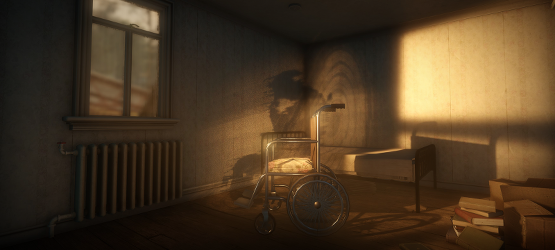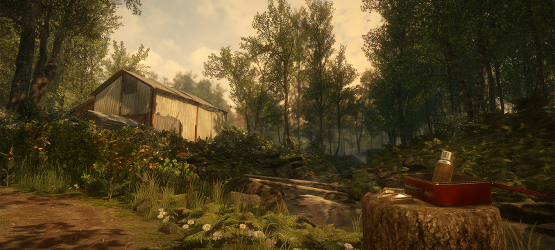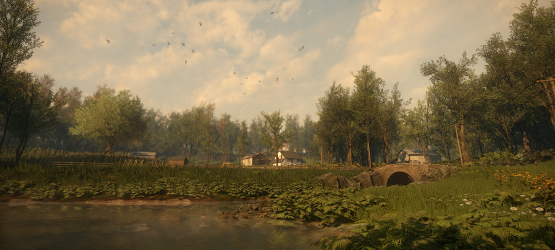Everybody’s Gone to the Rapture was announced at Gamescom 2013, and it’s an exclusive to the PlayStation 4. While it wasn’t on the floor at Sony’s booth this year at E3, it was shown behind closed doors. PSLS was invited in on a demo, and we have our preview for your reading pleasure.
Dan Pinchbeck, Creative Director at The Chinese Room, guided us through a short section of the game. Going into the demo, Pinchbeck stressed that while Sony Santa Monica is producing the game, they are by no means limiting the team; and are in fact giving them all the creative freedom they want, with the beefy PS4 hardware unsurprisingly not hampering development. The development team has ballooned from three to 13 almost overnight for the production of the game, and their vision is still clear with what they want to accomplish — tell a story in a way that only the videogame medium can. In Everybody’s Gone to the Rapture, the use of space, atmosphere, and emotion are the tools that the game will use to attempt to get the player to care about the story, which will hopefully get them to dive deeper into the narrative.
Rapture takes place in England in 1984. This is before the world of cellphones and Internet access, when the Cold War was the hot topic of the times. The game is, like its spiritual predecessor Dear Esther, meant to be a mystery that the player is tasked with solving. This is, according to The Chinese Room, a game about the people in the apocalypse, and not so much the apocalypse itself. You are seemingly left behind when the Rapture comes, with many unanswered questions and a whole world to explore. Specifically, there are six different locations that the player will visit. We saw about one-quarter of one area, including a lush farm and the surrounding brook.

In an effort to keep the player actively interested in the game’s story, it will not branch out much. While this might sound like a limitation at first, keeping the core story easy to follow and always moving forward rather than sideways will most likely help keep the player emotionally invested in the plot, and not struggle to remember what is going on by being sidetracked. This means the game has an estimated play time of around 3-3 1/2 hours, but of course, this will vary depending on how the game is played. The characters that you “meet” are seen as ghost-like orbs, and they act out events that occurred just prior to the Rapture. Since there are only five characters other than the player, you will “see” and hear them as they lived out the last fleeting days of their lives.
There is no way to “fail” or die in Rapture. As Pinchbeck said; the only possibility of failure here is a if the game doesn’t hook the player enough to care. Right now, any events that you trigger will only “play” once, such as a couple discussing some sort of “electromagnetic disruption” in a rather ominous conversation. However, the area where an event takes place doesn’t “die” afterwards. After interacting with other objects elsewhere, a return trip may sometimes net you another new event or interaction with the characters at a later time in their lives. The game does have a climax to its plot, so while it is an open world, eventually you will reach its inevitable ending.

Rapture looks absolutely gorgeous. In the area we saw, there were thousands of plants swaying in the wind, a large group of birds flying around overhead, and rays of sunshine flowing in under the trees. This was easily among the best-looking games I have seen at E3. The Chinese Room has created a believable, lived-in feeling world. You can really sense the emptiness of the houses and other buildings now that everyone is gone. Whether it’s a still-lit cigar next to an open toolbox or a still-hot pitcher of tea, much attention has been paid to by the developers on the little touches. In fact, Pinchbeck stated that their team noticed that what makes gamers connect with characters in games are the tiniest things, so they are going to try and get the player to connect to the game’s characters in this way.
In an effort to really drive home an emotional connection with the player, Rapture‘s audio was given special attention. For example, the audio engine dynamically generates ambiance at all times. We were shown the use of this when out in a grassy field, and I noticed how silent it felt while you could still hear the grass wafting in the wind. While exploring, occasionally a soundtrack will play, which features sweeping orchestral notes alongside angelic, almost choir-like singers.
For those who were worried that the move to a home console would detract from the experience, I am glad to say that you may rest easy. Nothing has been lost in transition. Everybody’s Gone to the Rapture looks gorgeous, sounds ethereal, is easy to play, and gives back to you as much as you put into it. As polished as the game looks already, it’s hard to believe it still won’t be out until 2015, but The Chinese Room is definitely taking their time to craft a story that they hope will stay with you for a long time to come. It looks like they will hit that mark, and we cannot wait to review it when the time comes.





